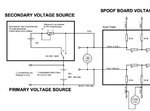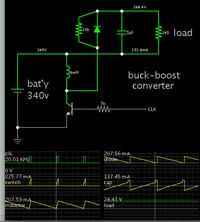chicowoodhill
Newbie level 4

I have an Electric Vehicle (EV). I replaced the original Nickle Metal Hydride (NiMH) batteries with Lithium Ion (LiON) batteries from a Ford Focus, and added a new charging system and battery management system (BMS). The traction pack is fully isolated from the vehicle chassis and electrical systems.
Even though it no longer manages the battery pack, I need to keep the old NiMH BMS functioning because it controls many of the vehicle's subsystems. To do this, I built a voltage divider that gives 25 taps off the new pack to spoof the original 25 batteries' voltage taps (I will eventually replace the pot with a microprocessor controller). This keeps the original BCM happy because it thinks it sees and is in control of the original pack. The BCM voltage sensing inputs are high impedance and draw virtually no current:

However, because the original NiMH pack and new LiON pack have different charge and discharge curves, the original BCM doesn't accurately track the SOC (state of charge) of the new pack. This affects the vehicle gauges and range. To compensate for this, I added an additional battery in series with the new pack so I can control the spoofed voltage to the original BCM. This allows me to fool it into seeing whatever cell voltages I want it to see. I have tested this idea and it works.
So my question is this: instead of using an additional battery to provide the boosted voltage I want, I'd like to replace it with a voltage source that is powered by one or more of the cells in the traction pack. But I'm confused about how to do this, since I don't know how to keep it isolated from its power source and mimic a standalone battery. My first idea is to use an off-the-shelf voltage booster for this, but again, I don't see how to power it from the pack and still put it in series with the pack voltage:

I feel like the answer should be obvious but it escapes me...can somebody tell me how to add a secondary voltage source in series with a primary voltage source and draw the power for the secondary source from the primary source? ...thanks...
Even though it no longer manages the battery pack, I need to keep the old NiMH BMS functioning because it controls many of the vehicle's subsystems. To do this, I built a voltage divider that gives 25 taps off the new pack to spoof the original 25 batteries' voltage taps (I will eventually replace the pot with a microprocessor controller). This keeps the original BCM happy because it thinks it sees and is in control of the original pack. The BCM voltage sensing inputs are high impedance and draw virtually no current:

However, because the original NiMH pack and new LiON pack have different charge and discharge curves, the original BCM doesn't accurately track the SOC (state of charge) of the new pack. This affects the vehicle gauges and range. To compensate for this, I added an additional battery in series with the new pack so I can control the spoofed voltage to the original BCM. This allows me to fool it into seeing whatever cell voltages I want it to see. I have tested this idea and it works.
So my question is this: instead of using an additional battery to provide the boosted voltage I want, I'd like to replace it with a voltage source that is powered by one or more of the cells in the traction pack. But I'm confused about how to do this, since I don't know how to keep it isolated from its power source and mimic a standalone battery. My first idea is to use an off-the-shelf voltage booster for this, but again, I don't see how to power it from the pack and still put it in series with the pack voltage:

I feel like the answer should be obvious but it escapes me...can somebody tell me how to add a secondary voltage source in series with a primary voltage source and draw the power for the secondary source from the primary source? ...thanks...



